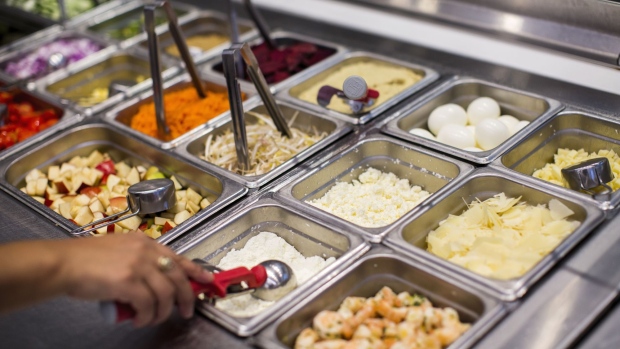Aug 18, 2021
The Sad Desk Salad Is Migrating From the Office to the Suburbs
, Bloomberg News

(Bloomberg) -- Before Covid-19 turned the American office worker into an endangered species, there were few more ubiquitous markers of this particular population than the office desk salad.
Once the province of city-center delis, salads became a fixture for those who didn’t have time for a lunch break but could shell out $18 for a quick midday meal. Chains like Just Salad, Sweetgreen, Chopt and Dig quickly proliferated in big cities, with lines frequently going out the door.
For years, this business model -- selling convenient, healthful permutations of meals served in bowls -- translated into double-digit location growth: 10.6% in 2018 and 12% in 2019, according to Datassential. Demand was not expected to slow.
But then the pandemic shuttered office buildings that fed the steady stream of customers through restaurant doors. Any business that relied on foot traffic suffered, and more than 110,000 restaurants in the U.S. closed permanently or long-term between March and December 2020, according to the National Restaurant Association. With the rise of work-from-home, the salad chains should have been doomed.
And yet, the desk salad is not only alive and well -- it is thriving. Despite meager 1.8% unit growth in 2020, the “limited-service salads / healthful” segment was the best performing of the entire restaurant industry by that metric, according to estimates from Datassential. Though office workers fled big cities, their lunch habits eventually resumed. And even as they do slowly return to the city, and rearrange their lives once again, the salad remains.
“The desk salad is a home desk salad now,” said Chopt chief executive officer Nick Marsh.
The salad chains are now looking beyond their once-core demographic. Chopt will open 40 more restaurants in the next two years, Marsh said, with 80% in the suburbs. In April, the Mediterranean chain Cava, a more suburban brand, announced it had raised $190 million to support its expansion. Just Salad, which closed an approximately $20 million funding round in July, said it will double its location count in the next two years, with an emphasis on the suburbs. In July, the New York Times reported on Sweetgreen’s own suburban expansion; the chain filed confidentially for an IPO in June.
“We are expanding faster than we ever have,” said Just Salad chief executive officer Nick Kenner. “We were opening stores in Florida pre-Covid. It just accelerated that opening process.”
The persistence of the desk salad, despite the geographic dislocation of its primary customer base, is at least partly attributable to the segment’s quick pivot to Covid-friendly delivery methods.
“About one-third of Salad / Healthful restaurant locations offered delivery in June 2020, but that percentage grew to more than three quarters of locations by the end of the year,” said Mark Brandau of Datassential.
Eighty percent of Cava’s locations are in the suburbs, which has paid off over the past 16 months. While sales at its office-dependent, high-density urban locations are still lower than in 2019, the rest of its portfolio is “significantly higher” than pre-pandemic levels, said chief executive officer Brett Schulman. “We knew from day one that lunch isn’t just served in the city.”
Dig was hit particularly hard because of its downtown focus and is still in the process of reopening many of its closed locations. “Our problem was that in core markets, particularly in New York, everybody just left,” said chief executive officer Adam Eskin. The chain may “shed a handful of units,” but is considering outposts in Long Island, Connecticut, New Jersey and Westchester, as well as suburbs of Boston and Philadelphia.
Without being tethered to the city office worker, salad chains are no longer just selling lunch.
“In the suburbs, we’re 60/40 lunch/dinner,” said Chopt’s Marsh. Just Salad’s dinner sales went from about 25% of its bottom line to nearly 40%, said Kenner. Dig sees dinner as a key to its success with the suburban consumer, too, said Eskin.
That’s not to say there aren’t headwinds, even in the suburbs: Cooking at home remains elevated compared to 2019. “In our most recent survey, in May, 78% of consumers said they intended to cook as much or more even as things get back to normal,” said McCormick’s chief executive officer Lawrence Kurzius in an interview. (The salad chains are capitalizing on that, too: Chopt now sells bottled dressings and Cava has a line of dips and spreads, including harissa and a jalapeno-infused feta.)
Companies, meanwhile, are trying to use lunch as a perk to lure workers back to the office. The French caterer Sodexo, through its acquisition of restaurant aggregator Foodee, now allows employees to order meals from local eateries to be delivered to their offices in 14 cities in the U.S. and Canada. Nestle’s Freshly, a microwaveable meal-delivery subsidiary, saw an early pandemic-driven spike during lockdowns, and then a separate wave of return-to-office growth from employer orders, according to chief executive officer Mike Wystrach.
And then there’s the expense. The already hefty price tag only gets higher when you add delivery fees and tips, not to mention inflation. On one mid-pandemic order from Sweetgreen, a $15.45 kale Caesar salad with steelhead salmon came with $10.86 in “other” fees, including tax, a service fee, a delivery fee and tip. Yet, consumers don’t seem to be blinking.
“The core consumer for a fast-casual salad chain is probably not so price-sensitive,” said Datassential’s Brandau. The combination of the health-halo from the salad with possibly fewer restaurant visits total thanks to working from home means that a $26 salad is within the realm of the acceptable for white-collar workers.
“Do you ‘make it count’ and have a salad, rather than trade down to a combo meal at a fast-food restaurant?” Brandau asks. “That’s what a salad-focused fast-casual chain is probably thinking.”
©2021 Bloomberg L.P.